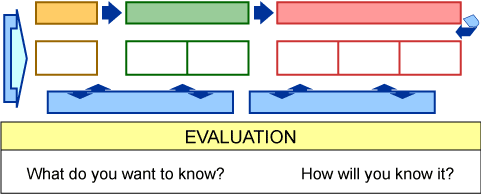Home » Enhancing Program Performance with Logic Models » Section 7: Using Logic Models in Evaluation » 7.1: Where does evaluation fit in a Logic Model?
7.1: Where does evaluation fit in a Logic Model?
The logic model describes your program or initiative: what it is expected to achieve and how. Evaluation helps you know how well that program or initiative actually works. “What worked, what didn’t, why?” “How can we make it better?”
Think about evaluation as integrated across your whole logic model as depicted in this graphic.

For our purposes we define evaluation as: “The systematic collection of information to make judgements, improve program effectiveness and/or generate knowledge to inform decisions about future programs.” (Patton, 1997)
About Evaluation Standards
“A standard is a principle mutually agreed by people engaged in a professional practice, that, if met, will enhance the quality and fairness of that professional practice, for example, evaluation.”
Joint Committee on Education Evaluation
Evaluation standards represent the agreed upon criteria for shaping and assessing our evaluation practice.
These standards provide guidance for the conduct of practical evaluation that is sound and fair. They are to be applied while planning and implementing an evaluation, as well as to assess the quality of a completed evaluation. The standards fall into four major categories:
- Utility: Serve the information needs of intended users.
- Feasibility: Be realistic, prudent, diplomatic, and frugal.
- Propriety: Act legally, ethically, and with regard for the welfare of those involved and affected.
- Accuracy: Reveal and convey technically accurate information.
You can learn more with our selected references on program evaluation. Download the list for your future use.




